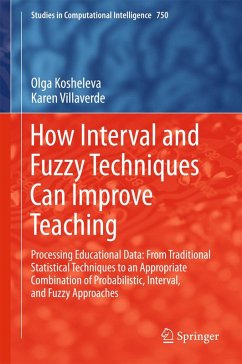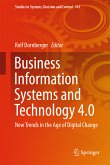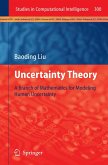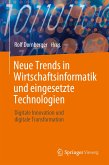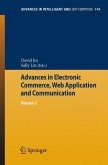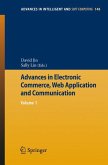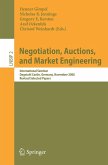Olga Kosheleva, Karen Villaverde
How Interval and Fuzzy Techniques Can Improve Teaching (eBook, PDF)
Processing Educational Data: From Traditional Statistical Techniques to an Appropriate Combination of Probabilistic, Interval, and Fuzzy Approaches
72,95 €
72,95 €
inkl. MwSt.
Sofort per Download lieferbar

36 °P sammeln
72,95 €
Als Download kaufen

72,95 €
inkl. MwSt.
Sofort per Download lieferbar

36 °P sammeln
Jetzt verschenken
Alle Infos zum eBook verschenken
72,95 €
inkl. MwSt.
Sofort per Download lieferbar
Alle Infos zum eBook verschenken

36 °P sammeln
Olga Kosheleva, Karen Villaverde
How Interval and Fuzzy Techniques Can Improve Teaching (eBook, PDF)
Processing Educational Data: From Traditional Statistical Techniques to an Appropriate Combination of Probabilistic, Interval, and Fuzzy Approaches
- Format: PDF
- Merkliste
- Auf die Merkliste
- Bewerten Bewerten
- Teilen
- Produkt teilen
- Produkterinnerung
- Produkterinnerung

Bitte loggen Sie sich zunächst in Ihr Kundenkonto ein oder registrieren Sie sich bei
bücher.de, um das eBook-Abo tolino select nutzen zu können.
Hier können Sie sich einloggen
Hier können Sie sich einloggen
Sie sind bereits eingeloggt. Klicken Sie auf 2. tolino select Abo, um fortzufahren.

Bitte loggen Sie sich zunächst in Ihr Kundenkonto ein oder registrieren Sie sich bei bücher.de, um das eBook-Abo tolino select nutzen zu können.
Includes the latest research on processing educational data
Presents traditional
Written by leading experts in the field
- Geräte: PC
- ohne Kopierschutz
- eBook Hilfe
- Größe: 4.38MB
Andere Kunden interessierten sich auch für
![Business Information Systems and Technology 4.0 (eBook, PDF) Business Information Systems and Technology 4.0 (eBook, PDF)]() Business Information Systems and Technology 4.0 (eBook, PDF)88,95 €
Business Information Systems and Technology 4.0 (eBook, PDF)88,95 €![Uncertainty Theory (eBook, PDF) Uncertainty Theory (eBook, PDF)]() Uncertainty Theory (eBook, PDF)112,95 €
Uncertainty Theory (eBook, PDF)112,95 €![Neue Trends in Wirtschaftsinformatik und eingesetzte Technologien (eBook, PDF) Neue Trends in Wirtschaftsinformatik und eingesetzte Technologien (eBook, PDF)]() Neue Trends in Wirtschaftsinformatik und eingesetzte Technologien (eBook, PDF)109,99 €
Neue Trends in Wirtschaftsinformatik und eingesetzte Technologien (eBook, PDF)109,99 €![Advances in Collective Intelligence 2011 (eBook, PDF) Advances in Collective Intelligence 2011 (eBook, PDF)]() Advances in Collective Intelligence 2011 (eBook, PDF)112,95 €
Advances in Collective Intelligence 2011 (eBook, PDF)112,95 €![Advances in Electronic Commerce, Web Application and Communication (eBook, PDF) Advances in Electronic Commerce, Web Application and Communication (eBook, PDF)]() Advances in Electronic Commerce, Web Application and Communication (eBook, PDF)160,95 €
Advances in Electronic Commerce, Web Application and Communication (eBook, PDF)160,95 €![Advances in Electronic Commerce, Web Application and Communication (eBook, PDF) Advances in Electronic Commerce, Web Application and Communication (eBook, PDF)]() Advances in Electronic Commerce, Web Application and Communication (eBook, PDF)160,95 €
Advances in Electronic Commerce, Web Application and Communication (eBook, PDF)160,95 €![Negotiation, Auctions, and Market Engineering (eBook, PDF) Negotiation, Auctions, and Market Engineering (eBook, PDF)]() Negotiation, Auctions, and Market Engineering (eBook, PDF)40,95 €
Negotiation, Auctions, and Market Engineering (eBook, PDF)40,95 €-
-
-
Includes the latest research on processing educational data
Presents traditional
Written by leading experts in the field
Presents traditional
Written by leading experts in the field
Dieser Download kann aus rechtlichen Gründen nur mit Rechnungsadresse in A, B, BG, CY, CZ, D, DK, EW, E, FIN, F, GR, HR, H, IRL, I, LT, L, LR, M, NL, PL, P, R, S, SLO, SK ausgeliefert werden.
Produktdetails
- Produktdetails
- Verlag: Springer Berlin Heidelberg
- Seitenzahl: 362
- Erscheinungstermin: 23. Oktober 2017
- Englisch
- ISBN-13: 9783662559932
- Artikelnr.: 52937726
- Verlag: Springer Berlin Heidelberg
- Seitenzahl: 362
- Erscheinungstermin: 23. Oktober 2017
- Englisch
- ISBN-13: 9783662559932
- Artikelnr.: 52937726
- Herstellerkennzeichnung Die Herstellerinformationen sind derzeit nicht verfügbar.
Introduction: Need for Interval and Fuzzy Techniques in Math and Science Education.-Part I How to Motivate Students.-How to Motivate Students? .-Need to Understand the Presence of Uncertainty: Emphasizing Paradoxes as a (Seemingly Paradoxical) Way to Enhance the Learning of (Strict) Mathematics .-Uncertainty-Related Example Explaining Why Geometry Is Useful: Geometry of a Plane .-Uncertainty-Related Example Explaining Why Calculus Is Useful: Example of the Mean Value Theorem .-How to Enhance Student Motivations by Borrowing from Ancient Tradition: Egyptian Fractions .-How to Enhance Student Motivations by Borrowing from Ancient Tradition: Mayan and Babylonian Arithmetics .-How to Enhance Student Motivations by Borrowing from Ancient Tradition: Babylonian Method of Computing the Square Root .-How to Enhance Student Motivations by Borrowing from Ancient Tradition: Russian Peasant Multiplication Algorithm .-How to Enhance Student Motivations by Borrowing from Modern Practices: Geometric Approach to Error-Less Counting .-How to Enhance Student Motivations by Borrowing from Modern Practices: Can We Learn Algorithms from People Who Compute Fast.-How to Enhance a General Student Motivation to Study: Asymmetric Paternalism .-Financial Motivation: How to Incentivize Students to Graduate Faster.-Part II In What Order to Present the Material.-In What Order to Present the Material.-Spiral Curriculum: Towards Mathematical Foundations.-How Much Time to Allocate to Each Topic?.-What is Wrong with Teaching to the Test: Uncertainty Techniques Help in Understanding the Controversy.-In What Order to Present the Material: Fractal Approach.-How AI-Type Uncertainty Ideas Can Improve Inter-Disciplinary Education and Collaboration: Lessons from a Case Study.-In What Order to Present the Material Within Each Topic: Concrete-First vs. Abstract-First .-Part III How to Select an Appropriate Way of Teaching Each Topic.-How to Select an Appropriate Way of Teaching Each Topic .-What is the Best Way to Distribute the Teacher's Efforts Among Students .-What is the Best Way to Allocate Teacher's Efforts: How Accurately Should We Write on the Board? When Marking Comments on Student Papers? .-How to Divide Students into Groups so as to Optimize Learning .-How to Divide Students into Groups: Importance of Diversity and Need for Intelligent Techniques to Further Enhance the Advantage of Groups with Diversity in Problem Solving .-A Minor but Important Aspect of Teaching Large Classes: When to Let in Late Students? .-Part IV How to Assess Students, Teachers, and Teaching Techniques.-How to Assess Students, Teachers, and Teaching Techniques.-How to Assess Students: Rewarding Results or Rewarding Efforts?.-How to Assess Students: Assess Frequently.-How to Assess Students: Surprise Them.-How to Assess Individual Contributions to a Group Project.-How to Access Students's Readiness for the Next Class.-How to Assess Students: Beyond Weighted Average.-How to Assess a Class .-How to Assess Teachers.-How to Assess Teaching Teachniques.-How to Assess Universities: Defining Average Class Size in a Way Which Is Most Adequate for Teaching Effectiveness.-Conclusions .
Introduction: Need for Interval and Fuzzy Techniques in Math and Science Education.-Part I How to Motivate Students.-How to Motivate Students? .-Need to Understand the Presence of Uncertainty: Emphasizing Paradoxes as a (Seemingly Paradoxical) Way to Enhance the Learning of (Strict) Mathematics .-Uncertainty-Related Example Explaining Why Geometry Is Useful: Geometry of a Plane .-Uncertainty-Related Example Explaining Why Calculus Is Useful: Example of the Mean Value Theorem .-How to Enhance Student Motivations by Borrowing from Ancient Tradition: Egyptian Fractions .-How to Enhance Student Motivations by Borrowing from Ancient Tradition: Mayan and Babylonian Arithmetics .-How to Enhance Student Motivations by Borrowing from Ancient Tradition: Babylonian Method of Computing the Square Root .-How to Enhance Student Motivations by Borrowing from Ancient Tradition: Russian Peasant Multiplication Algorithm .-How to Enhance Student Motivations by Borrowing from Modern Practices: Geometric Approach to Error-Less Counting .-How to Enhance Student Motivations by Borrowing from Modern Practices: Can We Learn Algorithms from People Who Compute Fast.-How to Enhance a General Student Motivation to Study: Asymmetric Paternalism .-Financial Motivation: How to Incentivize Students to Graduate Faster.-Part II In What Order to Present the Material.-In What Order to Present the Material.-Spiral Curriculum: Towards Mathematical Foundations.-How Much Time to Allocate to Each Topic?.-What is Wrong with Teaching to the Test: Uncertainty Techniques Help in Understanding the Controversy.-In What Order to Present the Material: Fractal Approach.-How AI-Type Uncertainty Ideas Can Improve Inter-Disciplinary Education and Collaboration: Lessons from a Case Study.-In What Order to Present the Material Within Each Topic: Concrete-First vs. Abstract-First .-Part III How to Select an Appropriate Way of Teaching Each Topic.-How to Select an Appropriate Way of Teaching Each Topic .-What is the Best Way to Distribute the Teacher's Efforts Among Students .-What is the Best Way to Allocate Teacher's Efforts: How Accurately Should We Write on the Board? When Marking Comments on Student Papers? .-How to Divide Students into Groups so as to Optimize Learning .-How to Divide Students into Groups: Importance of Diversity and Need for Intelligent Techniques to Further Enhance the Advantage of Groups with Diversity in Problem Solving .-A Minor but Important Aspect of Teaching Large Classes: When to Let in Late Students? .-Part IV How to Assess Students, Teachers, and Teaching Techniques.-How to Assess Students, Teachers, and Teaching Techniques.-How to Assess Students: Rewarding Results or Rewarding Efforts?.-How to Assess Students: Assess Frequently.-How to Assess Students: Surprise Them.-How to Assess Individual Contributions to a Group Project.-How to Access Students's Readiness for the Next Class.-How to Assess Students: Beyond Weighted Average.-How to Assess a Class .-How to Assess Teachers.-How to Assess Teaching Teachniques.-How to Assess Universities: Defining Average Class Size in a Way Which Is Most Adequate for Teaching Effectiveness.-Conclusions .
"The book is an attempt to present a unifying view of the papers on fuzzy techniques in different aspects of education ... Given that the references come from conference proceedings on computational intelligence, fuzzy systems, or informatics and publications like IEEE Transactions on Education, academics who attend such conferences seem to be the most likely readers, as well as any mathematicians interested in potential, if somewhat theoretical, applications of fuzzy sets and interval techniques." (Annie Selden, MAA Reviews, December, 2017)
